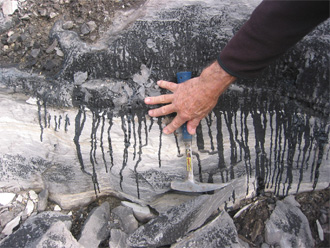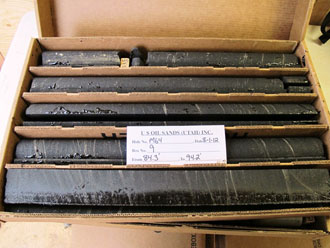The Resource |
Geologic Origins
The Uinta Basin formed during the Early Tertiary when tectonic events resulted in dramatic topographic elevation of surrounding highlands. The basin is flanked by the Uinta Mountains to the north, Douglas Creek Arch along its eastern margin, the Uncompahgre Plateau to the southeast, the San Rafael Swell to the southwest and the Wasatch Plateau to the west.
Contemporaneous with the Uinta Basin, the Piceance Creek Basin, rich in oil shale deposits, formed in northwestern Colorado. Sediments eroding from surrounding highlands flowed into the Lake Uinta basin, forming a thick sequence of organic-rich shale, limestone, and sandstone, providing all the elements necessary for the formation of the Basin's rich hydrocarbon resources, including the oil shale and oil sand present today in the southern part of the basin.
The bitumen resources occur within the Green River Formation, which is composed of shale, mudstone, sandstone, siltstone, limestone, marlstone and tuff. The Green River has been subdivided into four members: Evacuation Creek (youngest), Parachute Creek, Garden Gulch and Douglas Creek (oldest).
The bitumen-bearing sandstone beds in the area were not deposited as continuous layers but as numerous inter-tonguing, lenticular beds that are not correlative over large distances. Sandstone beds range in thickness from less than 1 foot to more than 30 feet. The extent of bitumen impregnation is controlled by porosity and permeability, distance from the source, hydrology and geological structure. Bitumen saturations from cores sampled in the vicinity of the proposed and permitted mine range up to 16 weight percent.


Bitumen Characteristics
Utah's Uinta Basin bitumen deposits contain 90% less sulfur than the bitumen found in Alberta's Athabasca region, meaning they are considered a sweet refinery feedstock. The Uinta Basin bitumen is less complex to refine, resulting in lower overall greenhouse gas emissions than those associated with refining of other heavy oil feedstocks.
Utah oil sands are "oil wet", meaning the bitumen adheres directly to the host sand grains. In contrast, Athabasca oil sands contain a film of connate water between the sand grain and the bitumen and are termed "water wet". The connate water allows bitumen to be extracted from Athabasca oil sands using the Clark Hot Water Process, originally developed at the University of Alberta in the 1920s. When this technique is applied to "oil wet" sands, only about 80% of the bitumen is recovered, leading US Oil Sands to develop its unique extraction method to achieve high bitumen recoveries in the mid-ninety percentage range.